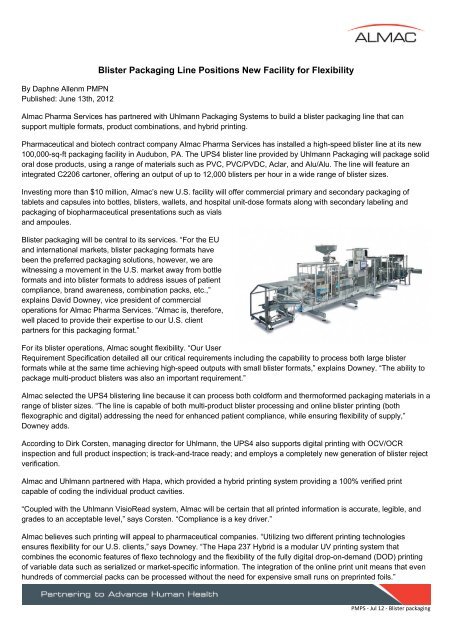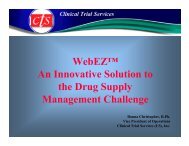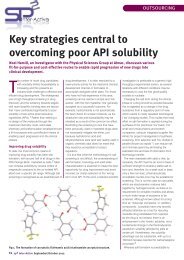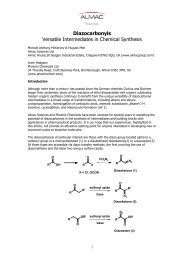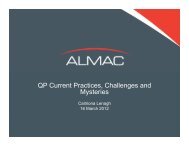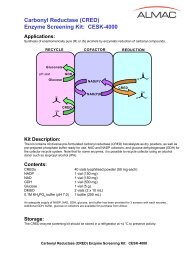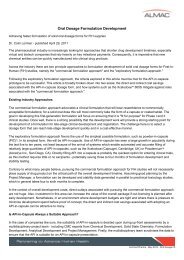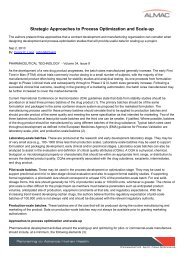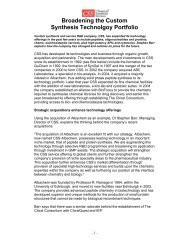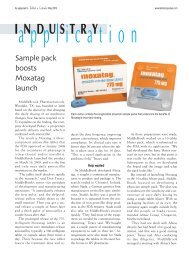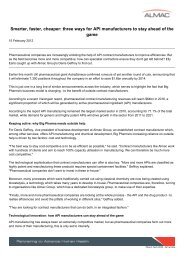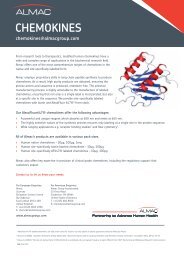Blister Packaging Line Positions New Facility for Flexibility - Almac
Blister Packaging Line Positions New Facility for Flexibility - Almac
Blister Packaging Line Positions New Facility for Flexibility - Almac
Create successful ePaper yourself
Turn your PDF publications into a flip-book with our unique Google optimized e-Paper software.
By Daphne Allenm PMPN<br />
Published: June 13th, 2012<br />
<strong>Blister</strong> <strong>Packaging</strong> <strong>Line</strong> <strong>Positions</strong> <strong>New</strong> <strong>Facility</strong> <strong>for</strong> <strong>Flexibility</strong><br />
<strong>Almac</strong> Pharma Services has partnered with Uhlmann <strong>Packaging</strong> Systems to build a blister packaging line that can<br />
support multiple <strong>for</strong>mats, product combinations, and hybrid printing.<br />
Pharmaceutical and biotech contract company <strong>Almac</strong> Pharma Services has installed a high-speed blister line at its new<br />
100,000-sq-ft packaging facility in Audubon, PA. The UPS4 blister line provided by Uhlmann <strong>Packaging</strong> will package solid<br />
oral dose products, using a range of materials such as PVC, PVC/PVDC, Aclar, and Alu/Alu. The line will feature an<br />
integrated C2206 cartoner, offering an output of up to 12,000 blisters per hour in a wide range of blister sizes.<br />
Investing more than $10 million, <strong>Almac</strong>’s new U.S. facility will offer commercial primary and secondary packaging of<br />
tablets and capsules into bottles, blisters, wallets, and hospital unit-dose <strong>for</strong>mats along with secondary labeling and<br />
packaging of biopharmaceutical presentations such as vials<br />
and ampoules.<br />
<strong>Blister</strong> packaging will be central to its services. “For the EU<br />
and international markets, blister packaging <strong>for</strong>mats have<br />
been the preferred packaging solutions, however, we are<br />
witnessing a movement in the U.S. market away from bottle<br />
<strong>for</strong>mats and into blister <strong>for</strong>mats to address issues of patient<br />
compliance, brand awareness, combination packs, etc.,”<br />
explains David Downey, vice president of commercial<br />
operations <strong>for</strong> <strong>Almac</strong> Pharma Services. “<strong>Almac</strong> is, there<strong>for</strong>e,<br />
well placed to provide their expertise to our U.S. client<br />
partners <strong>for</strong> this packaging <strong>for</strong>mat.”<br />
For its blister operations, <strong>Almac</strong> sought flexibility. “Our User<br />
Requirement Specification detailed all our critical requirements including the capability to process both large blister<br />
<strong>for</strong>mats while at the same time achieving high-speed outputs with small blister <strong>for</strong>mats,” explains Downey. “The ability to<br />
package multi-product blisters was also an important requirement.”<br />
<strong>Almac</strong> selected the UPS4 blistering line because it can process both cold<strong>for</strong>m and thermo<strong>for</strong>med packaging materials in a<br />
range of blister sizes. “The line is capable of both multi-product blister processing and online blister printing (both<br />
flexographic and digital) addressing the need <strong>for</strong> enhanced patient compliance, while ensuring flexibility of supply,”<br />
Downey adds.<br />
According to Dirk Corsten, managing director <strong>for</strong> Uhlmann, the UPS4 also supports digital printing with OCV/OCR<br />
inspection and full product inspection; is track-and-trace ready; and employs a completely new generation of blister reject<br />
verification.<br />
<strong>Almac</strong> and Uhlmann partnered with Hapa, which provided a hybrid printing system providing a 100% verified print<br />
capable of coding the individual product cavities.<br />
“Coupled with the Uhlmann VisioRead system, <strong>Almac</strong> will be certain that all printed in<strong>for</strong>mation is accurate, legible, and<br />
grades to an acceptable level,” says Corsten. “Compliance is a key driver.”<br />
<strong>Almac</strong> believes such printing will appeal to pharmaceutical companies. “Utilizing two different printing technologies<br />
ensures flexibility <strong>for</strong> our U.S. clients,” says Downey. “The Hapa 237 Hybrid is a modular UV printing system that<br />
combines the economic features of flexo technology and the flexibility of the fully digital drop-on-demand (DOD) printing<br />
of variable data such as serialized or market-specific in<strong>for</strong>mation. The integration of the online print unit means that even<br />
hundreds of commercial packs can be processed without the need <strong>for</strong> expensive small runs on preprinted foils.”<br />
PMPS ‐ Jul 12 ‐ <strong>Blister</strong> packaging
<strong>Almac</strong> also required flexibility with product feeding, Corsten reports, so the machine was equipped with a universal GMP<br />
flood feeder and dedicated product feeder. The machine is equipped with two punch stations; one <strong>for</strong> larger cards (up to<br />
270 mm × 280 mm) and a second punch <strong>for</strong> maximum output on smaller card sizes.<br />
The line will also include a Total Quality Control Centre (TQCC) incorporating a checkweigher and integrated print and<br />
vision system <strong>for</strong> auto-rejection of incorrect print/serialization data including 2-D codes.<br />
“As an FDA and EU approved outsourcing provider, quality is key in all our operations,” says Downey. “The TQCC was<br />
required as a means to ensure reliable quality and compliant product. The TQCC incorporates a checkweigher and<br />
integrated print and vision system <strong>for</strong> auto-rejection of incorrect print/serialization data including 2-D codes. The TQCC<br />
unit is separate to reduce impact on print quality and allow <strong>for</strong> the addition of future technology <strong>for</strong> example RFID.”<br />
Corsten says that the TQCC will also support <strong>Almac</strong>’s future flexibility. “<strong>Almac</strong> can even bring cartons produced off line, or<br />
in larger batches, and mark, verify, and checkweigh them on a stand alone unit,” he explains. “OCS/Wipotec was selected<br />
as the supplier because of its previous experience with these systems and its second-to-none industry reputation.”<br />
<strong>Almac</strong> chose the Uhlmann C2206 cartoner <strong>for</strong> its high-speed, flexibility, and ability to process large carton sizes (130 ×<br />
100 × 200 mm), Downey reports.<br />
The wide <strong>for</strong>mat range is possible thanks to a 6-in. pitch and the ability to handle all carton closure types (reverse tuck,<br />
hot melt, airplane, 4th panel), Corsten says.<br />
The cartoner employs a rotary booklet feeder and leaflet folder/feeder allowing multiple inserts per carton, he adds. “The<br />
system has the capability to insert either patient in<strong>for</strong>mation as a leaflet or a booklet or both. The leaflet option used is a<br />
GUK folder and folds the in<strong>for</strong>mation leaflet flat to the correct size to allow easy insertion,” says Downey. “Electronic<br />
verification ensures the correct component is being selected and inserted.”<br />
<strong>Almac</strong>’s main challenge with installing the blister packaging line was that the facility itself had to be converted from a<br />
clinical packaging site to one that could process commercial volumes, Downey says. “This required significant<br />
reconfiguration and construction of processing rooms.”<br />
Because of critical timelines and the size of the blister line, the Uhlmann technology was installed while the blistering<br />
processing room was being reconstructed, he adds.<br />
“Uhlmann was selected as <strong>Almac</strong>’s preferred blister line supplier as it was able to provide us with a versatile, high-spec<br />
blistering line to address our U.S. client requirements <strong>for</strong> high-quality, flexible commercial packaging solutions,” he says.<br />
In addition, Uhlmann’s presence as a local U.S. supplier was a “great benefit to <strong>Almac</strong>,” says Downey. “Uhlmann has<br />
provided valuable support to the <strong>Almac</strong> team at Audubon, PA. They have supported installation, validation, and<br />
commissioning of the blister line alongside providing onsite training <strong>for</strong> the technical/operational teams. Uhlmann will also<br />
provide local support <strong>for</strong> after-sales activities. The Uhlmann line was purchased with a full training package, and we take<br />
very seriously the ability of a supplier to support our operator training needs. The provision of local support and after sales<br />
service together with short lead times <strong>for</strong> engineering spares will be advantageous.”<br />
The blister line will complement the full suite of highly flexible commercial packaging equipment already installed in the<br />
new Audubon facility. Supporting high-volume marketed products to niche/orphan drug launches, additional technologies<br />
include bottling, walleting, and vial labeling and packaging.<br />
<strong>Almac</strong> has several products scheduled to be processed on the UPS4 line upon FDA approval in Fall 2012, says Downey.<br />
“All products processed on this line will be pharmaceutical products, primarily Rx products,” he adds.<br />
Corsten says that the “UPS4 line’s robust design and inherent flexibility make it well suited <strong>for</strong> product launches and short<br />
runs as well as multiple shift production with high yields and OEE <strong>for</strong> large SKUs.”<br />
PMPS ‐ Jul 12 ‐ <strong>Blister</strong> packaging


